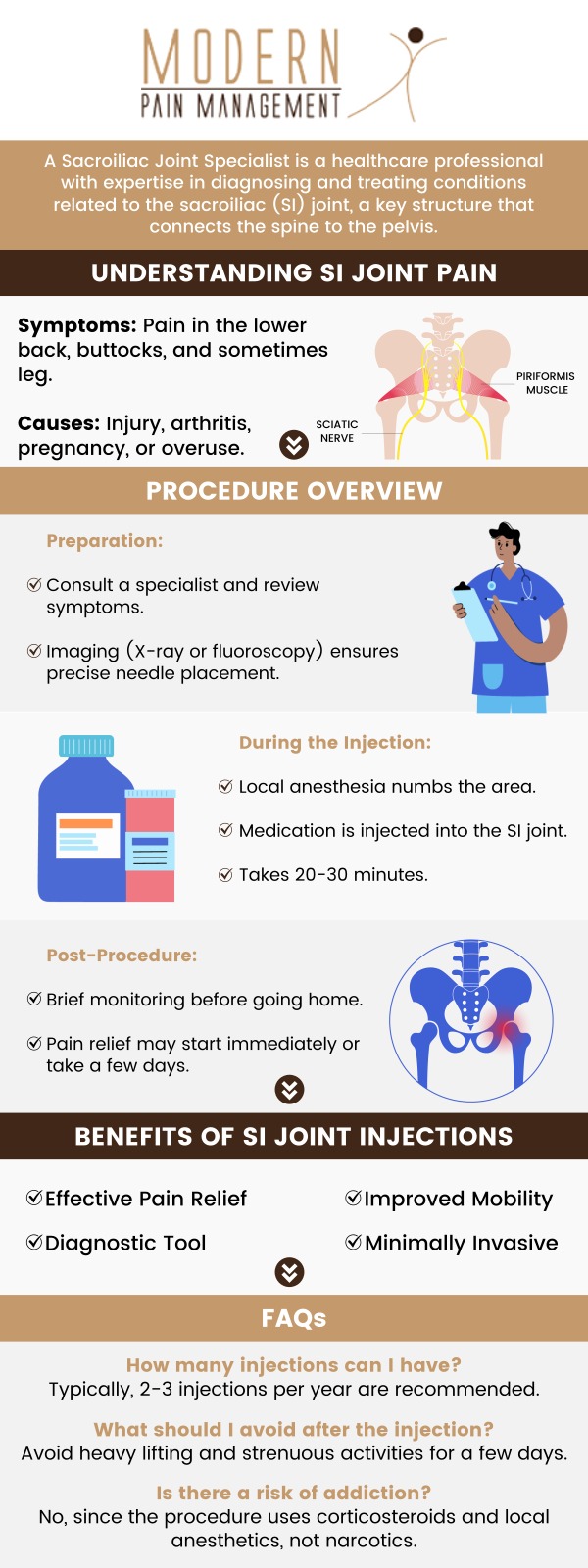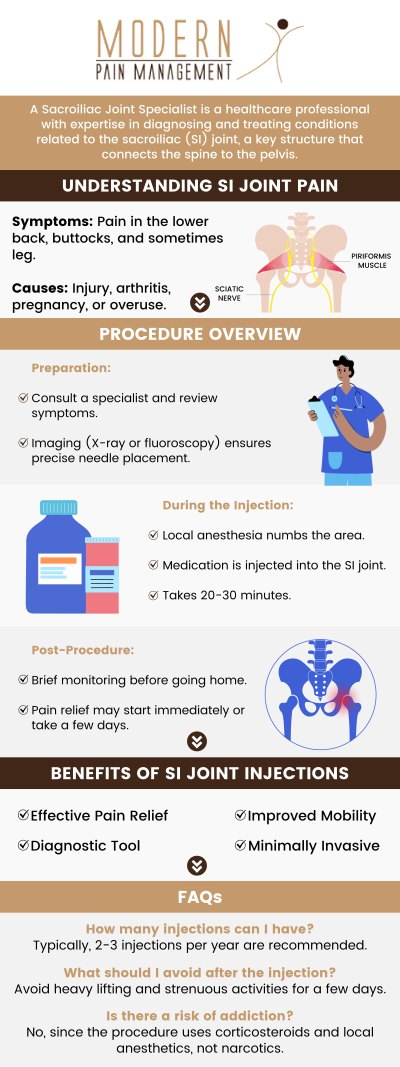What Does Sacroiliac Joint Pain Feel Like?
SI joint pain can range in intensity from acute and stabbing to dull and achy for some people. SI joint discomfort is most commonly felt in the lower back and buttocks, but it can also radiate to the hips, thighs, groin, and even the foot. Dr. Atallah, DO, and his team of professionals are capable of diagnosing your medical condition. Contact us or book an appointment online today for more information. We have convenient locations to serve you in Houston TX and Sugar Land TX.




Table of Contents:
Where is the sacroiliac joint?
Is it possible to prevent sacroiliac joint pain?
How can you tell if it is sacroiliac pain?
What are the best ways to relieve SI joint pain?
The sacroiliac joint is situated in the pelvis, linking the pelvis with the lower spine. This joint is pivotal in transferring forces and weight between the upper body and the legs. The sacroiliac joint comprises two parts: one located over the top part of the pelvis and the other positioned above the bony structure above the tailbone.
Given its placement in the body, the sacroiliac joint is integral to many functionalities. Pain in this joint can lead to numerous adverse health outcomes and limitations. Additionally, the sacroiliac joint functions as a shock-absorbing structure and is characterized by normally limited movement, which is essential for the smooth operation and movement capabilities of the joint.
The sacroiliac joint’s capacity to protect the lowest motion segment of the spine, thanks to its strong ligaments and limited motion, ensures it provides stable but flexible support to the upper body. This functionality enables spinal and thigh movements, facilitating walking, changes in posture, and efficiently distributing and controlling forces and weights.
Despite its robustness, the sacroiliac joint can be prone to dysfunction, often due to lateral movement or excessive movement. It can also be impacted by various conditions, including several types of arthritis, injury, infection, and other health risks, which can compromise its operations and movement capabilities.
While completely preventing sacroiliac joint pain can be challenging due to its potential causes and the natural progression of aging, certain steps can be taken to minimize the risk of experiencing this type of pain. Engaging in a generally healthy lifestyle, such as maintaining a healthy weight, can alleviate strain on the joints and other parts of the body.
Regular exercise not only strengthens the joints, making them less susceptible to injury but also contributes to overall joint health. Focusing on maintaining proper posture, especially while sitting to ensure an even distribution of weight across both hips and keeping the hips level, is crucial.
Additionally, taking precautions during vigorous exercise, high-impact exercise, or sports participation is essential to minimize the risk of SI joint pain. This includes using appropriate safety gear, avoiding overexertion, ensuring a proper warm-up, and maintaining correct form.
Identifying sacroiliac joint pain independently can be difficult since it may present similarly to several other conditions. This complexity is why the best course of action for accurately identifying SI pain involves visiting a pain management clinic like Modern Pain Management. There, specialists will conduct a thorough evaluation and order testing as necessary to aid in the early identification of SI pain, determine its cause, and facilitate prompt treatment interventions.
Despite the challenges of self-diagnosing SI joint pain, there are signs and symptoms individuals can be alert to that may indicate the onset of SI joint pain. These include experiencing a dull, achy pain or a sharp, stabbing pain, numbness, and tingling, which may present in the lower back, and buttocks and can extend down to the knees as well as the pelvis.
Patients might also notice a weakness or a lack of stability in the legs, leading to changes in gait such as taking shorter steps or limping. The pain may worsen when standing up from a seated position, during prolonged sitting, climbing stairs, and through other movements that can influence pain flare-ups.
The optimal approach to alleviating SI joint pain depends on accurately determining the cause of the pain. For those suffering from SI joint issues, a visit to a pain management clinic like Modern Pain Management is crucial. Treatments such as epidural steroid injections, SI joint injections, and a variety of regenerative medicines may be administered for both therapeutic and curative benefits.
Lifestyle modifications and physical therapies might be recommended in conjunction with manual physical manipulations to enhance the effectiveness of these treatments. Radiofrequency ablation and other advanced methods could also be explored ahead of considering surgical options, tailored to the specific needs of the patient.
Providers at Modern Pain Management also advise patients on self-care strategies to find symptomatic relief, depending on the cause of their SI joint pain. These strategies often involve a brief period of rest, avoiding excessive rest that could lead to stiffness, and finding relief through the application of ice or heat, which can collectively reduce inflammation and alleviate pain and muscle tension.
Over-the-counter medications, stretching exercises, and a carefully planned exercise regimen that avoids overstraining the affected area are also part of a comprehensive approach to finding relief from SI joint pain.
Sacroiliac joint pain treatment is available at Modern Pain Management. Contact us or book an appointment online today for more information. We have convenient locations to serve you in Houston TX and Sugar Land TX. We serve patients from Houston TX, Sugar Land TX, Pearland TX, Jersey Village TX, Missouri City TX, Stafford TX, Richmond TX, and the surrounding areas!
ADDITIONAL SERVICES YOU MAY NEED




